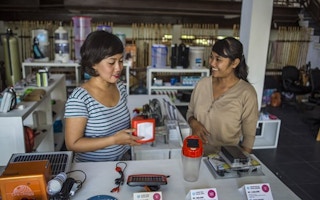Women, who regularly suffer more fatalities than men during disasters, still lack adequate safety measures despite growing awareness of the dangers they face, experts warn.
“I think the big thinkers and the governments are aware of the dangers, but what they don’t seem to know is what needs to be done to reverse the trend,” Emilienne De Leon Aulina, the executive director of the Mexico-based International Network of Women’s Funds (INWF) said in a telephone interview.
Terry Odendahl executive director and CEO of Global Greengrants Fund (GGF), a US-based non-governmental organisation that specialises in small grants of up to $5,000 for environmental projects, said that situation was clear during last December’s UN climate negotiations in Peru.
“There was a lot of rhetoric, but when it came to effective action on gender issues, there was back-sliding,” she said.
To help change that, the GGF, INWF and Alliance of Funds have launched a research guide that aims to help donors effectively fund gender-sensitive projects.
“
We see more and more corporations now taking serious note of environmental issues. We have to use that attention to build knowledge on how much of a disproportionate risk women carry.
Emilienne De Leon Aulina, executive director, Mexico-based International Network of Women’s Funds
“Most funders lack adequate programs or systems to support grassroots women and their climate change solutions. Men receive far greater resources for climate-related initiatives because they tend to wage larger-scale, more public efforts, whereas women’s advocacy is typically locally based and less visible, making it more difficult for funders to find and support,” the guide said.
It noted that only 0.01 per cent of all global grants address climate change and women’s rights together.
Aleta Baun, an Indonesian activist, said that before she began a grassroots organisation in her native island of West Timor in 1996, all the assistance programmes were developed after consultation with village men – not women.
Now in Asia, however, the Global Greengrants Fund is working with the South Asia Women’s Fund to identify areas where women need assistance in dealing with climate change in India andNepal.
Urgent Action Fund, a global women’s rights group, also is looking at funding a project in South America to identify where environmental and women’s issues overlap.
Smaller programmes more effective
Odendahl said the Global Greengrants Fund had also been talking with large international funders such as the World Bank and the Green Climate Fund in an effort to prepare more programmes aimed at women.
“We don’t have specific targets, but what we have told these groups is that smaller grants, smaller programmes are more effective in reaching women,” Odendahl said.
Both she and Aulina stressed the need for economic empowerment of women. In many cases, women find themselves left out of decision made about land they live on and use, while “men have a large say over these decisions,” Aulina said. The same is true for how profits from land are used.
Aulina said that if women had a larger share in the money earned from their land, their voices within and outside the community would become stronger.
She also said that governments were still slow to understand these dynamics. “We have to keep building awareness, keep building momentum so that decision makers understand the true situation,” Odendahl said.
The new report says programmes addressing women’s issue and environmental issues have historically operated in separate spheres, making collaboration rare.
One key area for progress is building linkages in the private sector, Aulina said.
“We see more and more corporations now taking serious note of environmental issues. We have to use that attention to build knowledge on how much of a disproportionate risk women carry” and to build gender sensitivity into programmes, she said.

















